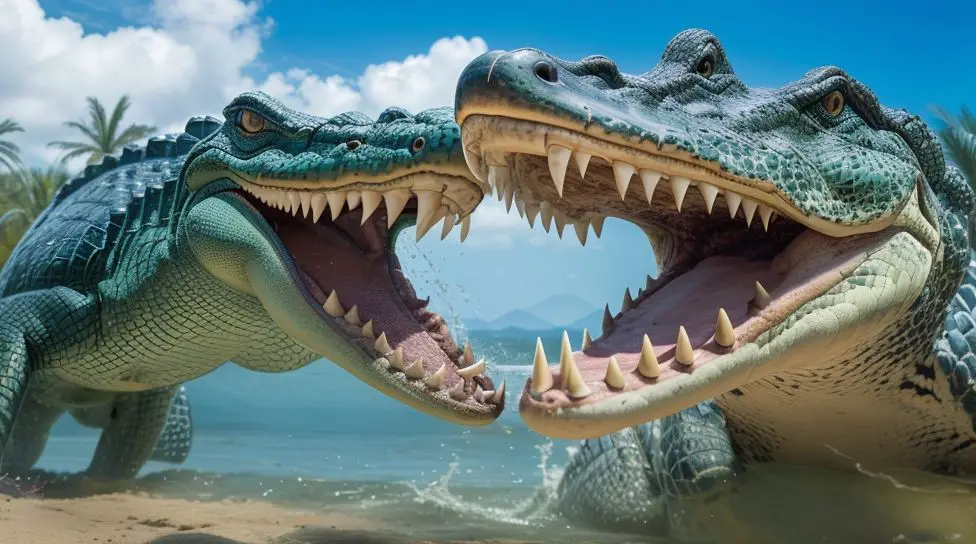Crocodiles are fascinating creatures that have captivated human interest for centuries. Among the various species of crocodiles, the Nile Crocodile and Saltwater Crocodile are two of the most well-known and often misunderstood. While they share some similarities, they also have distinct differences in their physical characteristics, habitat, behavior, and interactions with humans.
Physical Differences between Nile Crocodile and Saltwater Crocodile
- Size and Weight: The Saltwater Crocodile is the largest living reptile, reaching lengths of up to 23 feet and weighing over a ton, whereas the Nile Crocodile is slightly smaller, typically measuring around 16 feet in length.
- Body Shape and Coloration: The Nile Crocodile has a more streamlined body and a V-shaped snout, while the Saltwater Crocodile has a bulkier build and a broader snout. In terms of coloration, the Nile Crocodile often has a darker olive-brown color, while the Saltwater Crocodile tends to be lighter in color, ranging from gray to greenish-brown.
- Skull Structure: The skulls of the two crocodile species also differ. The Saltwater Crocodile has a more elongated skull with a narrow snout, whereas the Nile Crocodile has a broader skull and a more rounded snout.
- Teeth and Jaw Strength: Both crocodile species have a powerful bite, but the Saltwater Crocodile has the strongest bite force of any living animal, exerting immense pressure on its prey, while the Nile Crocodile has a slightly weaker bite force.
Habitat and Distribution
- Nile Crocodile Habitat: Nile Crocodiles inhabit freshwater habitats such as rivers, lakes, and marshes across sub-Saharan Africa.
- Saltwater Crocodile Habitat: As the name suggests, Saltwater Crocodiles are found in coastal areas, brackish estuaries, and freshwater rivers across the Indo-Pacific region, including Southeast Asia, northern Australia, and the western Pacific islands.
- Geographic Distribution: Nile Crocodiles are primarily found in countries like Egypt, Sudan, Ethiopia, and Kenya, while Saltwater Crocodiles have a wider range spanning from India, Bangladesh, and Sri Lanka to Australia and Papua New Guinea.
Behavior and Diet
- Nile Crocodile Behavior and Diet: Nile Crocodiles are known for being aggressive and territorial. They mainly feed on fish, but they are opportunistic predators and can prey on mammals, birds, and even other crocodiles.
- Saltwater Crocodile
Key takeaway:
- Nile Crocodile and Saltwater Crocodile have distinct physical differences, including size, body shape, coloration, skull structure, teeth, and jaw strength. Understanding these differences is essential for their identification and classification.
- Nile Crocodile and Saltwater Crocodile have different habitats and distribution patterns. Their specific preferences for water bodies and geographical ranges can help researchers and conservationists track and study these species.
- Nile Crocodile and Saltwater Crocodile exhibit different behavior and diet patterns. Understanding their behavior and dietary habits is crucial for their conservation and management, as well as for the safety of humans living in or near their habitats.
- Nile Crocodile and Saltwater Crocodile have distinct reproductive and nesting behaviors. Studying their reproduction patterns helps researchers understand their population dynamics and implement effective conservation strategies.
- Both Nile Crocodile and Saltwater Crocodile face threats to their survival and have varying conservation statuses. Recognizing and addressing these threats is essential for the long-term sustainability of these crocodile species.
- Interactions with humans differ between Nile Crocodile and Saltwater Crocodile. Understanding the risks associated with these interactions can help mitigate conflicts and ensure the safety of both humans and crocodiles.
Physical Differences between Nile Crocodile and Saltwater Crocodile
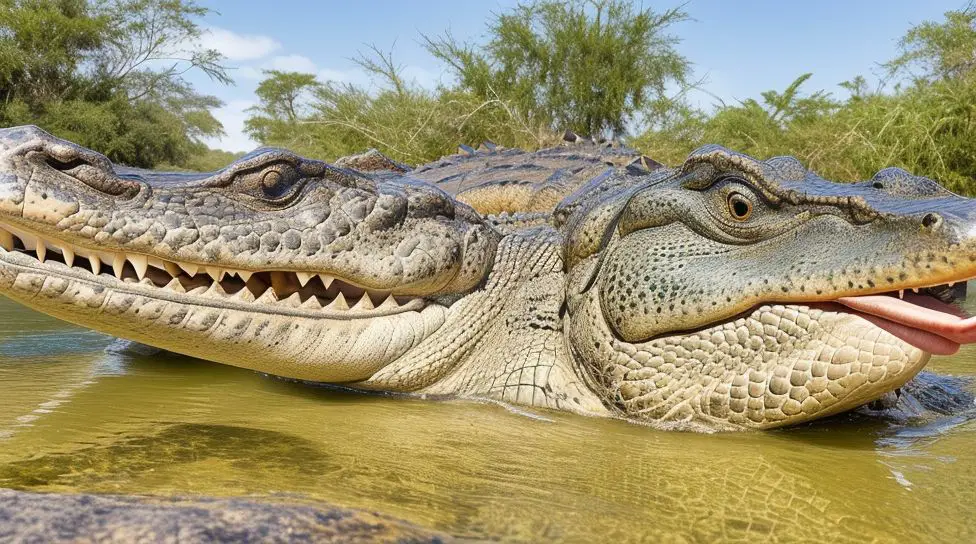
Photo Credits: Ruggedreptiles.Com by Logan Miller
When it comes to comparing the Nile Crocodile and the Saltwater Crocodile, their physical differences tell a fascinating story. In this exploration, we’ll dive into the distinct characteristics that set these mighty reptiles apart. From their size and weight to their body shape and coloration, skull structure, and teeth and jaw strength, we’ll uncover the captivating details that make each of these crocodile species truly unique. Prepare to be amazed by the diverse world of crocodile morphology!
Size and Weight
The size and weight of Nile crocodiles and saltwater crocodiles can vary significantly. Here is a comparison between the two:
| Aspect | Nile Crocodile | Saltwater Crocodile |
|
Size |
Compared to saltwater crocodiles, Nile crocodiles are smaller in size. Adult males typically measure around 13 to 16 feet long. |
Saltwater crocodiles, on the other hand, are the largest species of crocodiles. Adult males can grow anywhere between 17 to 23 feet in length. |
|
Weight |
In terms of weight, adult male Nile crocodiles generally weigh around 500 to 1,500 pounds. |
On the other hand, adult male saltwater crocodiles can weigh up to 2,200 to 2,500 pounds, making them one of the heaviest reptiles in the world. |
It is important to note that these measurements are averages and individual specimens may be larger or smaller than the stated range.
Pro-tip: When encountering Nile crocodiles or saltwater crocodiles in the wild, it is crucial to maintain a safe distance and avoid any interaction. These large reptiles are powerful and dangerous predators, and it is best to observe them from a distance to ensure your own safety.
Body Shape and Coloration
| Aspects | Nile Crocodile | Saltwater Crocodile |
| Body Shape | The Nile crocodile has a more streamlined and elongated body shape, which is suitable for swift movement in water. | The saltwater crocodile has a bulkier body shape, with a wider and stockier build, giving it immense power in the water. |
| Coloration | The Nile crocodile typically has a light olive-brown coloration on its back, blending in with its surroundings. The belly is usually lighter in shade. | The saltwater crocodile has a darker, almost blackish coloration on its back, providing camouflage in murky estuarine and coastal environments. The belly is lighter in color compared to the back. |
These differences in body shape and coloration are adaptations that allow each species to thrive in their respective habitats.
It’s important to note that both crocodile species are apex predators and have similar capabilities in terms of hunting and survival. The variations in body shape and coloration primarily reflect the different environments they inhabit and the specific ecological niches they occupy.
When encountering a Nile crocodile or saltwater crocodile, it’s vital to exercise caution and keep a safe distance. These creatures are powerful and can be potentially dangerous. Always respect their natural habitat and avoid any actions that may provoke them.
By understanding the distinctions in body shape and coloration, researchers and wildlife enthusiasts can better appreciate the diversity found in these incredible reptiles.
Skull Structure
The remarkable skull structure of the Nile crocodile and the saltwater crocodile plays a significant role in their overall anatomy and abilities. Both crocodiles possess specialized skull structures that enable them to be highly efficient and formidable predators in their respective habitats.
The skull of the Nile crocodile features a broad snout, which is advantageous for capturing and holding onto prey. The nasal bones are also well-developed to allow the crocodile to breathe while its head is partially submerged in water. This unique skull structure ensures that the Nile crocodile is well-equipped for hunting both in water and on land.
On the other hand, the saltwater crocodile has a narrower and longer skull, which enables it to engage in powerful bites. The snout is more pointed, allowing for swift and accurate attacks on its prey. This specialized skull structure gives the saltwater crocodile an advantage in capturing and subduing its prey.
Both crocodiles possess strong and sharp teeth, firmly embedded in their jaws. These teeth are specially designed for gripping and tearing flesh, ensuring effective feeding. The remarkable skull structure of the Nile crocodile is known for its robustness and thickness, which protects its brain and other vital organs. It also contributes to the Nile crocodile’s ability to exert powerful jaw pressure, allowing it to overpower its prey with ease.
In contrast, the skull structure of the saltwater crocodile is slightly lighter compared to its Nile counterpart. This lighter skull structure allows the saltwater crocodile to have greater agility both in water and during hunting, making it an even more efficient predator.
The skull structure of crocodiles is a testament to their remarkable adaptation over millions of years. These reptiles have maintained their unique anatomical features, including their specialized skull structures, which have made them formidable creatures in both water and on land.
Teeth and Jaw Strength
- Nile crocodiles possess longer and more slender teeth in comparison to saltwater crocodiles, which have broader and thicker teeth designed for crushing and tearing apart prey.
- The interlocking teeth of Nile crocodiles aid in securely grasping onto their prey, while saltwater crocodiles rely on their powerful jaw muscles to exert tremendous force when biting down.
- Both Nile crocodiles and saltwater crocodiles exhibit impressive jaw strength, with Nile crocodiles having well-developed jaw muscles and saltwater crocodiles possessing extremely powerful jaw muscles that give them a formidable biting force.
- Both species continuously replace their teeth throughout their entire lives, but the number and arrangement of teeth differ, with Nile crocodiles exhibiting a more uniform and symmetrical arrangement.
- Teeth and jaw strength play a vital role in the efficient capture, killing, and consumption of prey for these crocodiles.
Habitat and Distribution
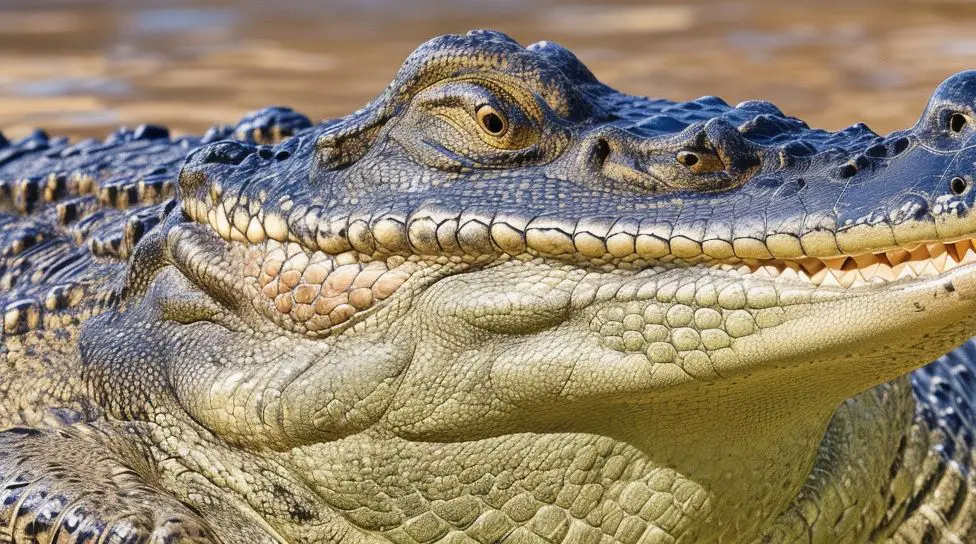
Photo Credits: Ruggedreptiles.Com by James Garcia
When it comes to the Nile Crocodile and the Saltwater Crocodile, their habitats and distribution play a crucial role. Let’s dive into the unique environments these fascinating creatures call home and explore their geographic distribution. From the swamps and rivers of the Nile to the vast coastal regions of the saltwater habitats, we’ll uncover the distinct territories these crocodiles conquer. Hold on tight as we venture into their world of survival and adaptation!
Nile Crocodile Habitat
The habitat of the Nile crocodile, also known as Nile crocodile habitat, consists of various freshwater environments, including rivers, lakes, and marshes, throughout Africa. This species, known for its formidable size and strength, has adapted to survive in specific habitats that suit its needs.
Nile crocodiles can be found in different water bodies across Africa, such as rivers, lakes, and marshes. They prefer freshwater habitats, particularly slow-moving rivers and lakes with dense vegetation. These habitats provide the necessary conditions for hunting, breeding, and basking in the sun, making them well-adapted to both hot and dry environments as well as wetland areas.
The choice of Nile crocodile habitat is influenced by the abundance of prey, which includes fish, reptiles, birds, and mammals. They prefer areas with sufficient food sources, which may vary depending on location and season. Suitable nesting sites are also essential for their reproductive success.
Across Africa, Nile crocodile populations can be found in countries like Egypt, Sudan, Kenya, Tanzania, and South Africa. Due to their ability to adapt to diverse habitats, they have a broad geographic distribution.
Conservation efforts for the Nile crocodile and its habitat are crucial. Addressing threats such as habitat destruction, poaching, and human-wildlife conflicts is essential. These conservation efforts should primarily focus on preserving their natural habitats and raising awareness about the importance of protecting these magnificent creatures.
Understanding the preferences of the Nile crocodile habitat is key to implementing effective conservation strategies to ensure the conservation of this species.
Saltwater Crocodile Habitat
The saltwater crocodile, also known as the estuarine crocodile, is primarily found in coastal areas and prefers habitats with brackish or saltwater. Its habitat, known as the saltwater crocodile habitat, encompasses a range of environments, including swamps, mangroves, rivers, and coastal marshes.
These crocodiles are highly adaptable and can tolerate various salinities, allowing them to thrive in both freshwater and marine environments. They are typically found in the tropical regions of Southeast Asia, Australia, and the Pacific islands, which are part of the extensive saltwater crocodile habitat.
In terms of specific locations, the saltwater crocodile can be found in the rivers and estuaries of countries such as Australia, India, Bangladesh, Myanmar, Vietnam, Malaysia, Indonesia, and Papua New Guinea. These countries have diverse saltwater crocodile habitat that caters to their needs.
Their preferred habitat of mangroves provides them with a perfect balance of land and water, allowing them to easily move between the two in their saltwater crocodile habitat. The dense vegetation and muddy channels of mangroves provide ample cover for hunting, resting, and nesting.
Saltwater crocodile habitat provides them with abundant prey, including fish, amphibians, reptiles, birds, and mammals – all part of the ecosystem that supports the saltwater crocodile habitat. These crocodiles are known for their ability to ambush their prey, using their powerful jaws to capture and submerge their victims.
It is important to note that saltwater crocodile habitat can be dangerous for humans as well. These crocodiles have been known to attack humans in their territory, particularly if they feel threatened, are defending their nest, or are seeking food within their saltwater crocodile habitat.
The diverse and extensive saltwater crocodile habitat spans from freshwater rivers to saltwater estuaries. Their adaptability, along with their strong hunting skills, contributes to their success as one of the largest and most formidable crocodile species in the world within their saltwater crocodile habitat.
Geographic Distribution of Nile Crocodile
The geographic distribution of Nile crocodiles covers a wide range of regions in Africa. Here is a table highlighting their distribution:
| Country | Regions |
|---|---|
| Egypt | Nile Valley, Lake Nasser |
| Sudan | Blue Nile, White Nile, Sudd |
| Ethiopia | Omo River, Lake Chamo |
| Uganda | Nile River, Lake Kyoga |
| Kenya | Lake Turkana, Tana River |
| Tanzania | Rufiji River, Zanzibar Islands |
| Rwanda | Akagera National Park |
| Burundi | Rusizi River |
| Democratic Republic of the Congo | Congo River, Lake Tanganyika |
| Malawi | Shire River, Lake Malawi |
| Zambia | Luangwa River, Zambezi River |
| Mozambique | Zambezi River, Save River |
| Zimbabwe | Limpopo River, Gonarezhou National Park |
Pro-tip: When studying the geographic distribution of Nile crocodiles, it is important to note that they are primarily found in the eastern and northeastern parts of the African continent, with the Nile River being a significant habitat. Understanding their distribution can aid in conservation efforts and promote coexistence with local communities.
Geographic Distribution of Saltwater Crocodile
python
The geographical distribution of the Saltwater Crocodile is predominantly concentrated in the Indo-Pacific region. This particular species of crocodile can be found in several countries, including Australia, Indonesia, Papua New Guinea, Malaysia, and the Philippines.
To visually represent the geographic distribution of the Saltwater Crocodile, a table has been provided below, showcasing the countries where this species can be found:
| Country | Geographic Distribution |
|---|---|
| Australia | Northern Australia, including the coastal regions of Queensland, Northern Territory, and Western Australia |
| Indonesia | Throughout the Indonesian archipelago, particularly in Sumatra, Borneo, and Papua |
| Papua New Guinea | Coastal regions and river systems of Papua New Guinea |
| Malaysia | Mainly in the states of Sarawak and Sabah on the island of Borneo |
| Philippines | Primarily in the southern islands of the Philippines, including Palawan and Mindanao |
Fun fact: The Saltwater Crocodile is the largest living reptile, with some individuals reaching lengths of over 20 feet and weighing up to 2,000 kilograms. Their impressive size and territorial nature make them one of the most formidable predators in their habitat.
Behavior and Diet
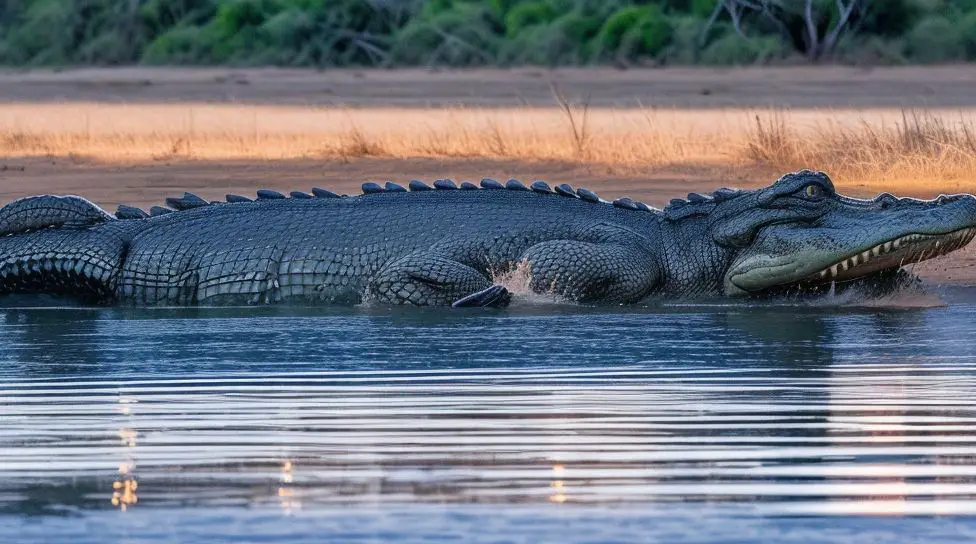
Photo Credits: Ruggedreptiles.Com by Sean Gonzalez
When it comes to the behavior and diet of Nile crocodiles and saltwater crocodiles, there are fascinating distinctions that set them apart. In this section, we’ll dive into the intriguing behaviors and dietary habits of these formidable creatures. From the Nile crocodile’s hunting techniques to the saltwater crocodile’s preferred prey, prepare to be amazed by the fascinating details of these apex predators.
Nile Crocodile Behavior and Diet
- The behavior and diet of Nile crocodiles are fascinating. They are known to be opportunistic predators, feeding on a wide variety of prey including fish, birds, mammals, and even other reptiles.
- These crocodiles possess highly skilled hunting techniques. They use their stealth and powerful jaws to ambush and capture their prey.
- A notable behavior of Nile crocodiles is their capability of fast movements in water. They can swim silently towards their prey before launching a surprise attack.
- They have a unique hunting technique called “lunge feeding,” where they propel themselves out of the water to catch prey that is standing on the water’s edge.
- Due to their high metabolism, Nile crocodiles require a substantial amount of food to survive. In fact, they can eat up to 50% of their body weight in one meal.
- Dietary studies have shown that fish, particularly during the dry season when other food sources are scarce, primarily make up the diet of Nile crocodiles.
- During the annual migration across rivers, Nile crocodiles are also known to feed on large mammals such as wildebeests and zebras.
- It is important to note that while Nile crocodiles have a powerful bite, they do not chew their food. Instead, they swallow their prey whole or tear it into smaller pieces before consuming it.
Fun Fact: Nile crocodiles have a unique behavior called “sulting,” where they bask in the sun with their mouths open. This helps regulate their body temperature and also attracts birds known as “crocodile birds” that clean their teeth and feed on parasites.
Saltwater Crocodile Behavior and Diet
Saltwater crocodiles are renowned for their aggressive behavior and diverse diet. These crocodiles, known as opportunistic predators, will consume almost anything that crosses their path. The saltwater crocodile is also recognized as the largest living reptile. Adult males can reach lengths of 6-7 meters and weigh approximately 1,000 kilograms.
When it comes to behavior, saltwater crocodiles exhibit high territoriality and can be extremely aggressive, particularly during the breeding season. They fiercely defend their territory and will attack any intruders, including humans, who venture too close. This predatory behavior stems from their natural instinct to safeguard their offspring and ensure their own survival.
In terms of diet, saltwater crocodiles have a diverse range of prey. They are known to feast on fish, turtles, birds, mammals, and even other reptiles. Their powerful jaws and sharp teeth enable them to capture and kill their prey effectively. With a bite force of approximately 3,700 pounds per square inch, they possess one of the strongest bites among all creatures.
Despite their aggressive nature, saltwater crocodiles play a vital role in maintaining the balance of their ecosystem. They are key in controlling populations of prey species and also prevent the spread of diseases by scavenging from carcasses.
Fact: Were you aware that the saltwater crocodile has the ability to swallow small prey whole? Their stomach is incredibly flexible and can expand to accommodate large meals.
Reproduction and Nesting
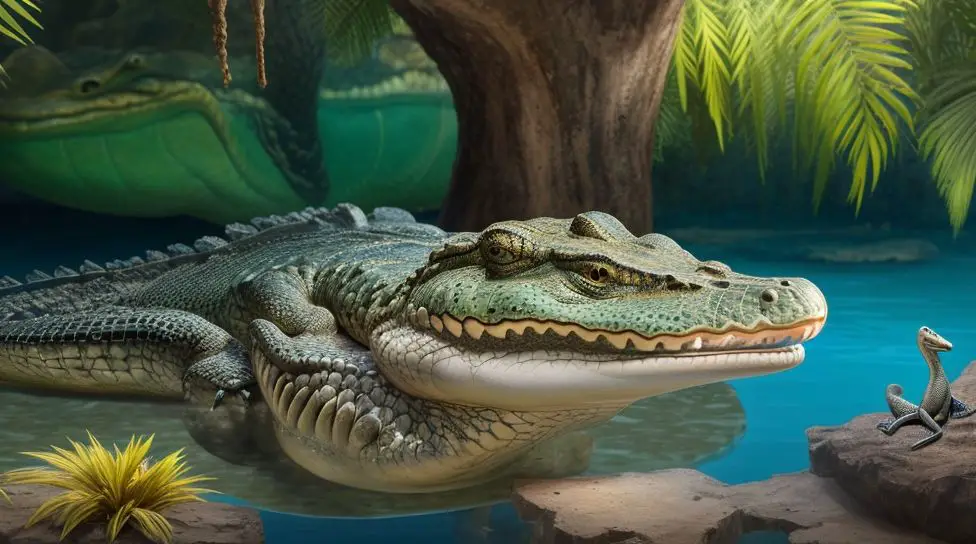
Photo Credits: Ruggedreptiles.Com by Stephen Hill
When it comes to the reproduction and nesting habits of the Nile crocodile and the saltwater crocodile, there are fascinating differences worth exploring. We’ll dive into the unique characteristics and behaviors of each species in this section. From the distinct strategies employed by Nile crocodile in reproduction and nesting to the intriguing methods employed by the saltwater crocodile, get ready to discover the astonishing world of crocodile reproduction and nesting. Hold on tight, it’s going to be a wild ride!
Nile Crocodile Reproduction and Nesting
Nile crocodile reproduction and nesting involve a unique process where the female Nile crocodile constructs her nest on land near water. Using her strong limbs, she digs holes in the ground, often choosing sandy areas or riverbanks for ideal nesting locations. This nesting season primarily occurs during the dry season when water levels are low, creating the perfect conditions for laying eggs.
During nesting, the female Nile crocodile lays a clutch of eggs, ranging from 25 to 80. To protect the eggs from predators and maintain a stable temperature, she covers them with soil or vegetation. The heat from the sun plays a crucial role in the incubation process, which typically lasts around 80 to 90 days.
Interestingly, the gender of the Nile crocodile hatchlings depends on the incubation temperature. Lower temperatures result in female hatchlings, while higher temperatures lead to males. This temperature-dependent sex determination is a fascinating aspect of Nile crocodile reproduction.
Once the hatchlings are ready to emerge, they use their egg tooth to break through the shell and make their way to the water. Unlike the female crocodile, the female Nile crocodile plays no role in caring for the hatchlings. Instead, the young crocodiles begin their independent lives, facing various threats and challenges from predators and environmental factors.
Understanding the reproductive process of Nile crocodiles is crucial for conservation efforts. It emphasizes the vulnerability of nesting sites and the significance of ensuring favorable conditions for successful hatching and survival of this species.
Saltwater Crocodile Reproduction and Nesting
Saltwater crocodile reproduction and nesting are fascinating aspects of their life cycle. These remarkable reptiles typically reach sexual maturity at around 10 to 12 years old. During the courtship phase, males attract females through vocalizations, head slapping, and bubble blowing. Once a pair has bonded, they engage in mating, which usually occurs in the water.
After mating, the female crocodile searches for a suitable nesting site, usually in sandy areas close to water sources such as rivers or lakes. Saltwater crocodile reproduction and nesting involve the construction of an elevated and well-protected mound, also known as a nest. The female uses her powerful hind limbs to dig this mound, providing a safe and warm environment for the eggs.
The female then carefully lays her eggs, with a typical range of 40 to 60 eggs depending on her size and health. Placing the eggs in the center of the nest, she ensures they are covered with sand for protection. This nest acts as an incubator, maintaining a consistent temperature essential for the development of the embryos.
The incubation period lasts approximately 80 to 90 days, during which the temperature determines the sex of the offspring. Higher temperatures produce males, while lower temperatures result in females. Throughout this crucial period, the female crocodile remains close to the nest, diligently guarding it against potential predators.
Once the eggs hatch, the tiny hatchlings instinctively make their way to the water, guided by natural cues such as the sound of splashing. Despite their small size, these vulnerable hatchlings face multiple dangers, including predators like birds and monitor lizards.
Saltwater crocodile reproduction and nesting are key elements in the survival of these magnificent creatures. Understanding these processes plays a pivotal role in the efforts of conservationists to protect both the reptiles and their habitats.
Threats and Conservation Status
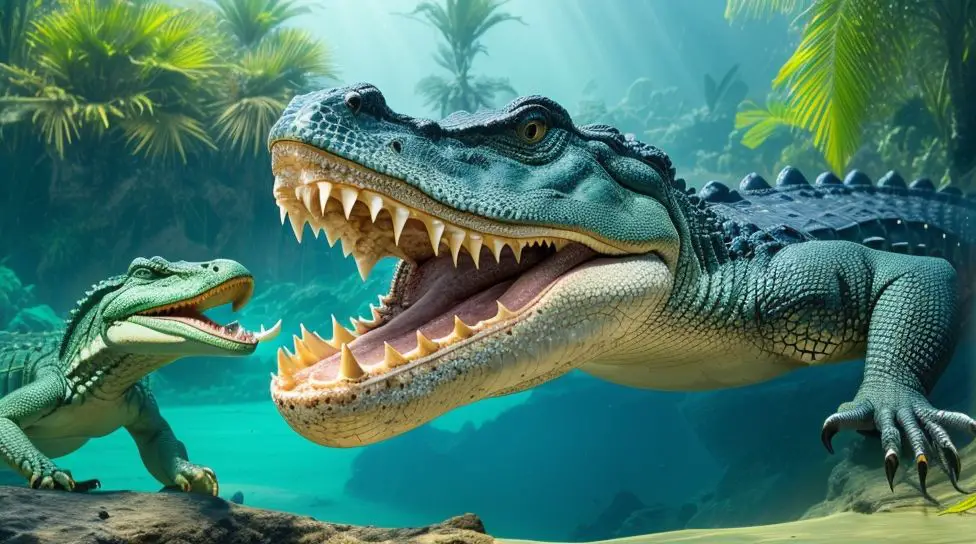
Photo Credits: Ruggedreptiles.Com by Joshua Wilson
Amidst the intriguing world of Nile crocodiles and saltwater crocodiles, let’s dive into the realm of threats and conservation status. Unveiling the perilous challenges faced by these magnificent reptiles, we’ll explore the current predicament they encounter in their respective habitats. Get ready to unravel the urgency surrounding Nile crocodile conservation status and the critical measures in place to protect the saltwater crocodile population. It’s an eye-opening journey, shedding light on these fascinating creatures’ plight and the efforts being made to preserve their existence.
Nile Crocodile Conservation Status
The Nile crocodile, classified as a species of least concern in terms of conservation status, is currently not facing any major threats or risks of extinction, indicating a stable population. To ensure their long-term survival, it is necessary to monitor and manage the conservation of Nile crocodiles.
The primary focus of conservation efforts for Nile crocodiles lies in protecting their natural habitats and managing their interactions with humans. Preserving the wetland and river ecosystems where these crocodiles reside is crucial as it is vital for the species’ survival. This involves maintaining water quality, preventing habitat destruction, and managing water flow.
Efforts are also directed towards reducing conflicts between Nile crocodiles and humans. This includes educating communities living near crocodile habitats about the importance of coexisting with these animals and implementing safety measures to minimize the risk of human-crocodile conflict.
Conservation organizations and governmental agencies collaborate to monitor and regulate hunting and trade of Nile crocodiles and their products, specifically skins, to prevent overexploitation and ensure the species is not threatened by illegal activities.
Although the Nile crocodile is not currently in immediate danger, continued conservation efforts are essential to maintain its population and preserve its role within the ecosystems it inhabits.
Saltwater Crocodile Conservation Status
The conservation status of the saltwater crocodile, also known as Saltwater Crocodile Conservation Status, is currently listed as “Least Concern” by the International Union for Conservation of Nature (IUCN). This designation indicates that the population of saltwater crocodiles is stable and not at significant risk of extinction in their natural habitat. It is important to keep in mind, however, that this status does not imply the absence of threats to the species.
The saltwater crocodile faces various challenges that affect its conservation efforts. One such challenge is habitat loss and degradation caused by human activities like land development and deforestation. These activities pose a significant threat to the species as they require large areas of intact coastal habitats for nesting, breeding, and feeding. Additionally, illegal hunting and poaching for their valuable skins and body parts continue to impact saltwater crocodile populations in certain regions.
To ensure the long-term survival of the saltwater crocodile, conservation efforts are vital. Implementing measures such as the establishment of protected areas, habitat restoration, and regulation of hunting and trading of crocodile products can greatly contribute to preserving their populations. It is crucial for governments, conservation organizations, and local communities to collaborate in order to effectively conserve and manage saltwater crocodiles.
Continuously monitoring the status of the saltwater crocodile population and the threats they face is essential to make informed conservation decisions. By implementing appropriate conservation measures, we can make a positive impact on the continued survival and well-being of this iconic species.
Interaction with Humans
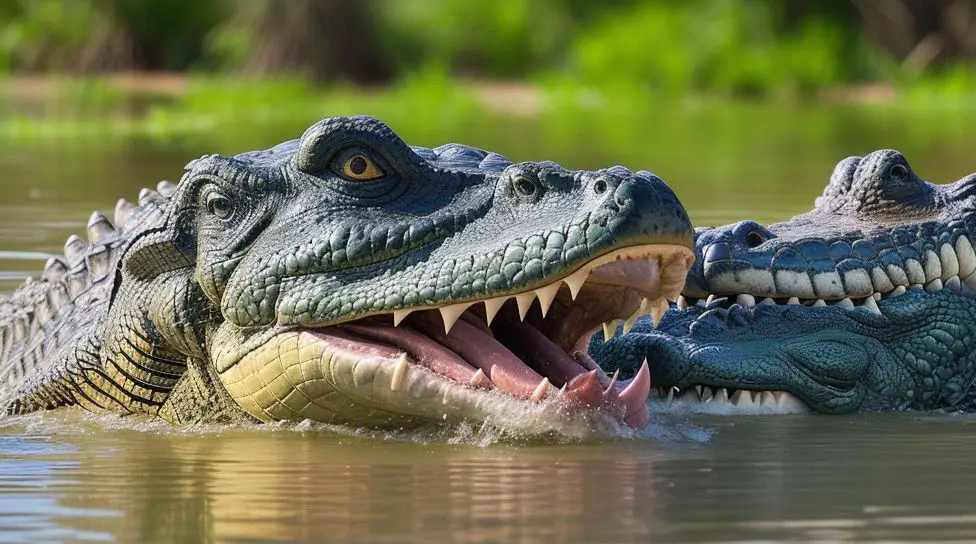
Photo Credits: Ruggedreptiles.Com by John Robinson
When it comes to our interaction with crocodiles, it’s vital to understand the differences between the Nile crocodile and the saltwater crocodile. In this section, we’ll dive into their encounters with humans, exploring the alarming statistics and shocking incidents. From attacks by the Nile crocodile to the aggressive behavior of the saltwater crocodile, we’ll uncover the perilous interactions that have left lasting impacts on both humans and these formidable creatures. Brace yourself for some jaw-dropping facts and real-life encounters!
Attacks on Humans by Nile Crocodile
Nile Crocodiles have gained a reputation for being aggressive and have been known to launch attacks on humans. These unforeseen incidents often happen when individuals are close to or in bodies of water. With their powerful jaws, Nile Crocodiles can deliver a forceful bite, allowing them to overpower their prey, which, in certain situations, can unfortunately include humans.
Reports of Nile Crocodile attacks on humans have been documented in various regions, particularly in parts of Africa where they are found. Due to the crocodile’s formidable bite, these attacks can result in severe injuries or even fatalities.
Therefore, it is crucial for people residing in or visiting areas inhabited by Nile Crocodiles to be well-informed about the potential risks and to take necessary precautions. This includes refraining from swimming or approaching water bodies where crocodiles are known to reside. Additionally, it is vital to adhere to local safety guidelines and regulations to minimize the likelihood of an encounter with a Nile Crocodile.
To summarize, while attacks on humans by Nile Crocodiles are a possibility, exercising caution and implementing necessary measures when within their habitats is of utmost importance. By promoting education and awareness about crocodile behavior, the risk of these potentially hazardous encounters can be reduced.
Attacks on Humans by Saltwater Crocodile
Saltwater crocodiles, also known as "salties," are notorious for their dangerous nature and frequent attacks on humans. These reptiles have developed a predatory instinct and often view humans as potential prey, especially when they are near bodies of water.
Areas where humans and saltwater crocodiles coexist, such as rivers, estuaries, and coastal regions, are more prone to these attacks. Therefore, it is crucial to exercise caution and remain vigilant when entering such habitats.
Activities like fishing, swimming, and wading in and around water bodies pose a higher risk of encountering saltwater crocodile attacks. These reptiles are experts at ambushing their prey from the water, underscoring the importance of being mindful of their presence.
Even boat or kayak excursions can turn perilous if saltwater crocodiles are provoked or feel threatened. To avoid such situations, maintaining a safe distance and showing respect for their natural environment is vital.
Minimizing the risk of attacks requires following local safety guidelines and regulations, particularly in areas known to house saltwater crocodiles. These guidelines may include refraining from swimming in waters known to be infested with crocodiles, utilizing designated swimming areas, and seeking the companionship of knowledgeable guides.
It is crucial to recognize that attacks on humans by saltwater crocodiles are a serious concern. By understanding their behavior, preferred habitats, and adhering to safety protocols, the likelihood of encountering such hazardous situations can be significantly reduced. Always prioritize personal safety and exhibit reverence for the innate instincts of these powerful reptiles.
The Nile Crocodile vs. Saltwater Crocodile, What’s the Difference?
- ✅ Nile crocodiles are commonly larger than saltwater crocodiles, despite having the same maximum size. (Source: Our Team)
- ✅ Saltwater crocodiles are frequently recognized as the largest living reptile species. (Source: Our Team)
- ✅ Nile crocodiles belong to the Crocodylus niloticus species, while saltwater crocodiles belong to the Crocodylus porosus species. (Source: Our Team)
- ✅ The name “saltwater crocodile” designates a specific species, not the animal’s habitat. (Source: Our Team)
- ✅ Nile crocodiles are found in sub-Saharan Africa, while saltwater crocodiles can be found in rivers, swamps, and coastal waters from the east coast of India through much of Southeast Asia. (Source: Our Team)
Frequently Asked Questions
What is the difference between the Nile crocodile and the saltwater crocodile?
The Nile crocodile and the saltwater crocodile are two different species of crocodile. The Nile crocodile (Crocodylus niloticus) is commonly found in sub-Saharan Africa, while the saltwater crocodile (Crocodylus porosus) can be found in rivers, swamps, and coastal waters from the east coast of India through much of Southeast Asia.
Which crocodile species is larger, the Nile crocodile or the saltwater crocodile?
Although both crocodile species have the same maximum size, the saltwater crocodile is generally recognized as the largest living reptile species. It can grow up to 23 feet and weigh approximately 2200 pounds, making it taller than an elephant.
Why are Nile crocodiles more deadly than saltwater crocodiles?
Despite being smaller, Nile crocodiles are considered more aggressive and deadly compared to saltwater crocodiles. They have a stronger bite force and pose a serious threat to people’s lives, with an estimated 1,000 human fatalities annually.
Can saltwater crocodiles mate with Nile crocodiles?
Although saltwater crocodiles and Nile crocodiles are geographically separated and saltwater crocodiles are poor swimmers, genetically, they are compatible with each other and can mate.
What are the distinctive features of crocodiles?
Crocodiles, including Nile crocodiles and saltwater crocodiles, have powerful jaws and teeth, short legs with clawed toes, and thick scaly skin. They have a long snout and a small brain compared to their body size. Their nostrils, ears, and eyes are above the water while the rest of their body is hidden underwater.
Are Nile crocodiles and saltwater crocodiles ambush predators?
Yes, both Nile crocodiles and saltwater crocodiles are ambush predators. Nile crocs usually ambush prey in or near water, while saltwater crocs prefer to wait near water before launching an attack.

